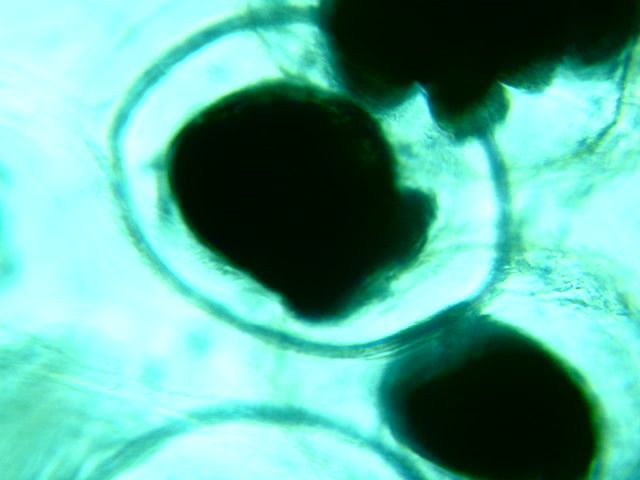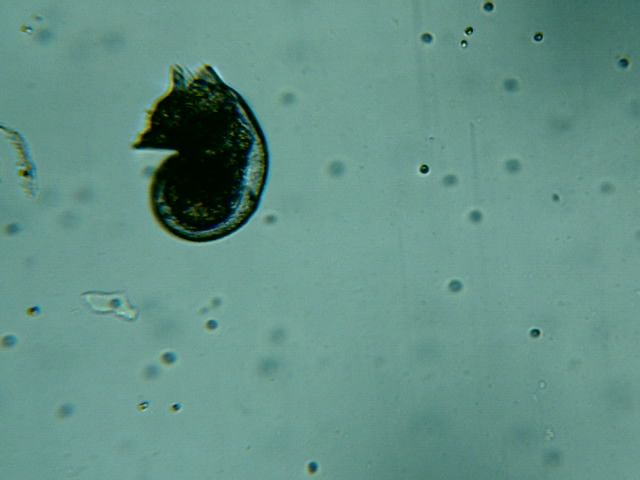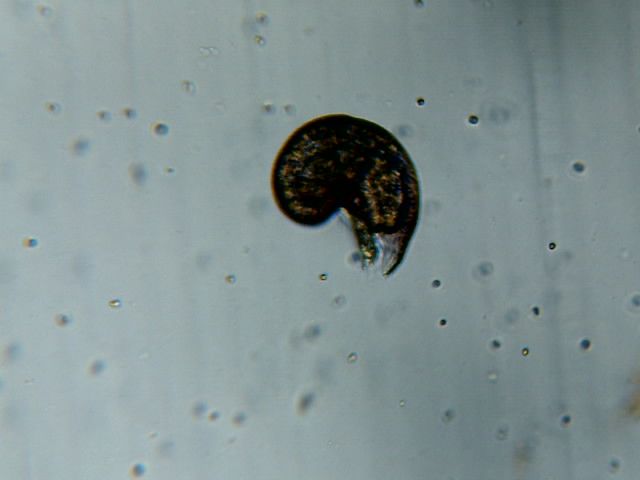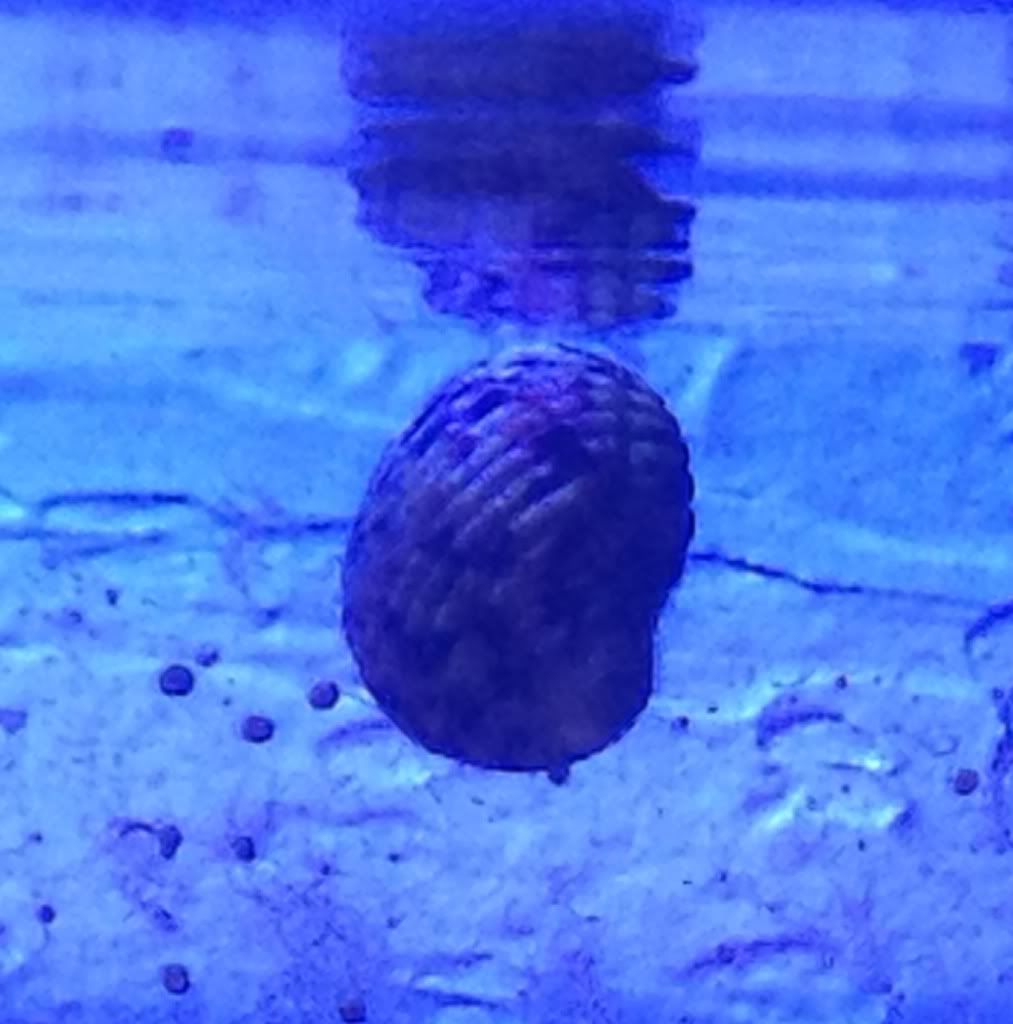Change Page: < 123 > | Showing page 2 of 3, messages 21 to 40 of 42 - powered by ASPPlayground.NET Forum Trial Version
Author
|
Message

|
 Re: Breeding Journal, Species: Nerita tessellata
Monday, August 5, 2013 2:08 PM
Re: Breeding Journal, Species: Nerita tessellata
Monday, August 5, 2013 2:08 PM
( permalink)
Well the first batch did not make it Andy, I don't know when they died, but it was probably after a week of me getting back from the conference trip (one or two weeks ago.) But what I did is I got another batch just yesterday, I don't know when the eggs were laid, but they were on the glass so I collected them. One thing that I have noticed, is that these egg spawns, on the glass, look close to IDENTICAL with those of a cerith snail's, when on the glass at least. Another thing that I had noticed, with the last batch especially, is that after they died off, I could not find any Isochrysis algae at all in the bottle, so I can assume that they are feeding on it. Before these eggs had hatched (yesterday) I had put in around 1/2 a mason jar full of Isochrysis into the container, which pretty much means I filled the bottle with algae, just to see what happened. Will the algae grow on the eggs and not let them hatch? Will the algae get onto the eggs and kill the fry? Were just a few of the questions I wanted to find answers to. Both answers were a big NO. I looked into the bottle a few minutes ago and saw hundreds, maybe even THOUSANDS of these fry swimming in the water column. I'm going to try this method and see what happens, it is similar to my last attempt, but this time there is much more Isochrysis algae in the water. Here is a photo of the larvae yesterday (first pic) taken at around 4 or 5pm MSD and a photo of them today, taken a few minutes ago (second pic)  
|
|
|
 Re: Breeding Journal, Species: Nerita tessellata
Tuesday, August 6, 2013 8:51 AM
Re: Breeding Journal, Species: Nerita tessellata
Tuesday, August 6, 2013 8:51 AM
( permalink)
Today I seem to be finding a mix of these guys, some look like the bottom photo from above, and the rest look like this:  With the second, they move slower, and also do not do the "spining" feeding tactic anymore, which is one thing I noticed yesterday. This "spinning" feeding occured as follows: Larvae spins in circles, from slow to fast, making a small vortex in the process, bringing the algae to the larvae. Is the next stage of these guys? Or are they just starving?? It also seems like this one has two whirls on it, but looking at the second photo before it seems that had two whirls to! - Strike that, only some of the larvae do that, which I presume are the unhealthy/dying ones. Here is a video (hard to tell which stage it is, but it is infact a stage 2 of these guys) on them feeding on Isochrysis: It starts at around 15 seconds when the feeding behavior begins
|
|
|
 Re: Breeding Journal, Species: Nerita tessellata
Tuesday, August 6, 2013 10:14 AM
Re: Breeding Journal, Species: Nerita tessellata
Tuesday, August 6, 2013 10:14 AM
( permalink)
Okay, hard question: Keep an eye out for these guys dying of starvation. If you suspect that you might want to start thinning them out early. It's tough to do, but fewer larvae might mean that more survive if you are constantly running short of Iso.
I'll go watch your movie now....
--Andy, the bucket man. "Not to know the mandolin is to argue oneself unknown...." --Clara Lanza, 1886
|
|
|
 Re: Breeding Journal, Species: Nerita tessellata
Tuesday, August 6, 2013 10:17 AM
Re: Breeding Journal, Species: Nerita tessellata
Tuesday, August 6, 2013 10:17 AM
( permalink)
The movie snail certainly looks happy. I think Iso is a winner for them.
--Andy, the bucket man. "Not to know the mandolin is to argue oneself unknown...." --Clara Lanza, 1886
|
|
|
 Re: Breeding Journal, Species: Nerita tessellata
Tuesday, August 6, 2013 10:32 AM
Re: Breeding Journal, Species: Nerita tessellata
Tuesday, August 6, 2013 10:32 AM
( permalink)
Yes, the one in the vid was one of a few that I found like that swimming. Only a few didn't eat and those I just through out after looking at them for a little bit. I'll probably do more and thin out more as they start dying. Although I don't think I'll be running short on Iso anytime soon. Got another 5 mason jars full just waiting to be used on something! Question for you Andy, comparing the first picture to the second, in the second picture the "mouth" is more elongated and skinnier with part of the "shell?" Growing next to it. Is this correct?
|
|
|
 Re: Breeding Journal, Species: Nerita tessellata
Tuesday, August 6, 2013 5:54 PM
Re: Breeding Journal, Species: Nerita tessellata
Tuesday, August 6, 2013 5:54 PM
( permalink)
So, Andy, as you stated before, the topic of how to do the dead/dying snails. I have attempted a method that might work. What I do is split the water from the "mother container" into around 7 containers (wine testers that Jim graciously gave me) and that leaves just a small amount on the bottom of the container which holds the dead/egg mass. Then I empty that out and rinse it with fresh RO/DI water.  I'll be doing this every day from now on, for the first two weeks. Then, after that (since it is their estimated starvation period) I will be doing the "water changes" once a week.
|
|
|
 Re: Breeding Journal, Species: Nerita tessellata
Tuesday, August 6, 2013 7:00 PM
Re: Breeding Journal, Species: Nerita tessellata
Tuesday, August 6, 2013 7:00 PM
( permalink)
 Originally Posted by Question for you Andy, comparing the first picture to the second, in the second picture the "mouth" is more elongated and skinnier with part of the "shell?" Growing next to it. Is this correct? The truth is, the soft body of the snail is able to change shape enormously. No telling what the "real" shape is supposed to be. (Was that your question?)
 Originally Posted by wine testers that Jim graciously gave me Is that what those are? I love those things. Best shipping containers ever. I was really talking about the possibility of culling the live snails if you see that having too many in your culture is inhibiting the whole bunch. Invert scientists do this all the time so they can concentrate their time/energy/water quality into fewer larvae, hopefully improving the possibility of getting more through in the end.
--Andy, the bucket man. "Not to know the mandolin is to argue oneself unknown...." --Clara Lanza, 1886
|
|
|
 Re: Breeding Journal, Species: Nerita tessellata
Tuesday, August 6, 2013 8:15 PM
Re: Breeding Journal, Species: Nerita tessellata
Tuesday, August 6, 2013 8:15 PM
( permalink)
Ah that makes sense. Besides culling, I think this is killing, tell me if I'm wrong here, but could I also just split the cultures into the wine testers then A.) work them in the cultures, or B.) Split them into more algae containers. Also, I understand the concept of them changing into different shapes, but how rare would it be that after 2-3 days most are all the EXACT same shape? I'm thinking this is one of their benthic larval stages that they turn in to, obviously I'd have to run a few more sets of eggs (when I get more, they are not in the mood anymore!) just to make sure that these are larval stages I'm seeing and not just them moving and morphing into shapes they wanna be in.
<message edited by Amphispur on Tuesday, August 6, 2013 9:13 PM>
|
|
|
 Re: Breeding Journal, Species: Nerita tessellata
Tuesday, August 6, 2013 9:08 PM
Re: Breeding Journal, Species: Nerita tessellata
Tuesday, August 6, 2013 9:08 PM
( permalink)
Yes, culling is killing. Consider, though, that in a snail pair's life they average getting two successful progeny to adulthood. (I say this because reef censuses over the years show that population figures are surprisingly stable for most species. In other words, most animals roughly manage to replace themselves over the course of their reproductive lifespans. And that's it.) So if you get twenty to adulthood, those genes have already been enormously successful by comparison with norms in the wild. And twenty is much, much better than zero.
I'm not telling you to cull them. You have to make that decision. But, if you run low on food and/or water quality and/or time and/or space, do consider it.
The next stage that you want them to go through (that you'll be able to see) is where those two big, ciliated lobes pull together and merge to become the snails' feeding appendage (trunk, snout, whatever). If you still see the cilia then they haven't gone through it yet. That change is pretty much the equivalent of fishes' meta. After that point, the snail has no real way to move around in the water column (since the cilia are gone) and pretty much better be benthic at that point. That's your big cue. So long as you still see the cilia they still need phyto.
--Andy, the bucket man. "Not to know the mandolin is to argue oneself unknown...." --Clara Lanza, 1886
|
|
|
 Re: Breeding Journal, Species: Nerita tessellata
Tuesday, August 6, 2013 9:12 PM
Re: Breeding Journal, Species: Nerita tessellata
Tuesday, August 6, 2013 9:12 PM
( permalink)
Ah ok thanks! So as soon as cilia is gone, they don't need phyto and are settled. So even when the shell is growing, and the cilia is merging, would it stay merged and still be cilia for a few days possibly? such as they run around with an almost merged cilia for awhile? Thanks for all the info Andy, it really helps!
|
|
|
 Re: Breeding Journal, Species: Nerita tessellata
Tuesday, August 6, 2013 9:31 PM
Re: Breeding Journal, Species: Nerita tessellata
Tuesday, August 6, 2013 9:31 PM
( permalink)
The times I've seen it, it's a pretty quick transition. But I wasn't watching planktonic veligers. Here's the story, though:
 Originally Posted by In many species, induction of metamorphosis occurs as a sensory response to a chemical cue indicative of the juvenile and/or adult habitat. Often this cue (the inducer) is a water soluble chemical secreted by the adult food. Induction of metamorphosis results in the larva settling to the substratum. This settlement may be followed by a "searching" phase as the larva apparently looks for an appropriate place to metamorphose. When metamorphosis occurs, the velum is lost, and the newly metamorphosed juvenile adopts its slug-like adult form. http://en.wikipedia.org/wiki/Veliger Basically, the larvae has found food and now it's time to eat. So they pretty quickly develop the ability. And that is, of course, when they really start putting on the growth.
--Andy, the bucket man. "Not to know the mandolin is to argue oneself unknown...." --Clara Lanza, 1886
|
|
|
 Re: Breeding Journal, Species: Nerita tessellata
Tuesday, August 6, 2013 9:56 PM
Re: Breeding Journal, Species: Nerita tessellata
Tuesday, August 6, 2013 9:56 PM
( permalink)
Ah ok thanks! Well that sounds like an interesting experiment for me to try out! I'm thinking of putting in macroalgae into a container, and one of the parents. Since it has to do with a chemical done by either the parents or the young/
|
|
|
 Re: Breeding Journal, Species: Nerita tessellata
Tuesday, August 6, 2013 10:00 PM
Re: Breeding Journal, Species: Nerita tessellata
Tuesday, August 6, 2013 10:00 PM
( permalink)
Yeah. Whatever it is that the parents will eat, whether that means scraping the walls of the aquarium or whatever. It helps that the parents often get the algae growing right on their shells.
At some point, though, you should try to get them to meta without going through all that. Some don't seem to need the cue (or it's from something common that'll show up on the wall of your rearing vessel any way).
--Andy, the bucket man. "Not to know the mandolin is to argue oneself unknown...." --Clara Lanza, 1886
|
|
|
 Re: Breeding Journal, Species: Nerita tessellata
Tuesday, August 6, 2013 10:16 PM
Re: Breeding Journal, Species: Nerita tessellata
Tuesday, August 6, 2013 10:16 PM
( permalink)
That test, the "control" if one could say, is what I am doing right now. If I get anymore spawns out of these guys, I'll expand and try different cues and see if those work faster/better.
|
|
|
 Re: Breeding Journal, Species: Nerita tessellata
Tuesday, August 6, 2013 10:38 PM
Re: Breeding Journal, Species: Nerita tessellata
Tuesday, August 6, 2013 10:38 PM
( permalink)
Andy, would these larvae be Veliger or Trochophore? I'm a little confused on what a trochophore is compared to a veliger, it seems as though these are mostly the same?
|
|
|
 Re: Breeding Journal, Species: Nerita tessellata
Tuesday, August 6, 2013 10:39 PM
Re: Breeding Journal, Species: Nerita tessellata
Tuesday, August 6, 2013 10:39 PM
( permalink)
Disregard that last post, all the difference is is just the families 
|
|
|
 Re: Breeding Journal, Species: Nerita tessellata
Tuesday, August 6, 2013 10:45 PM
Re: Breeding Journal, Species: Nerita tessellata
Tuesday, August 6, 2013 10:45 PM
( permalink)
Trochophores are an earlier stage. These are definitely veligers. This is what a trochophore looks like: 
--Andy, the bucket man. "Not to know the mandolin is to argue oneself unknown...." --Clara Lanza, 1886
|
|
|
 Re: Breeding Journal, Species: Nerita tessellata
Tuesday, August 6, 2013 10:49 PM
Re: Breeding Journal, Species: Nerita tessellata
Tuesday, August 6, 2013 10:49 PM
( permalink)
Ah, ok thanks Andy!
|
|
|
 Re: Breeding Journal, Species: Nerita tessellata
Tuesday, August 6, 2013 10:53 PM
Re: Breeding Journal, Species: Nerita tessellata
Tuesday, August 6, 2013 10:53 PM
( permalink)
Sure. Yeah, trochophores are basically just bags with mouths. Way the heck early development.
--Andy, the bucket man. "Not to know the mandolin is to argue oneself unknown...." --Clara Lanza, 1886
|
|
|
 Re: Breeding Journal, Species: Nerita tessellata
Saturday, September 14, 2013 6:43 PM
Re: Breeding Journal, Species: Nerita tessellata
Saturday, September 14, 2013 6:43 PM
( permalink)
Well, it seems throughout this whole mess I've forgotten a BIG thing (Thanks Matt!) the PARENTS! Here is the only one I could get NOT hiding in the rocks: 
|
|
|
|